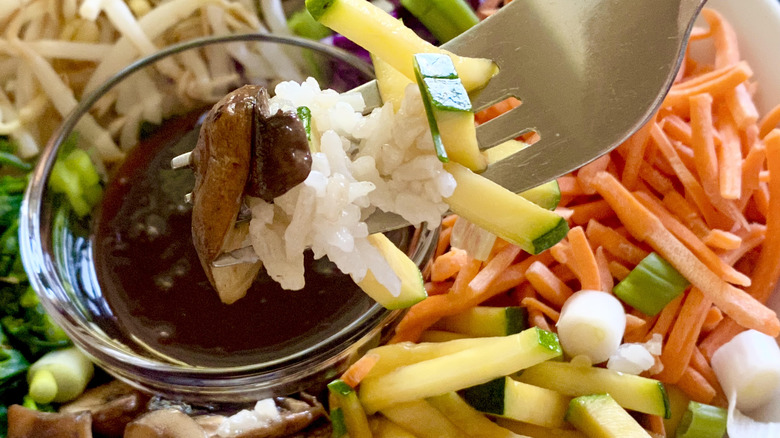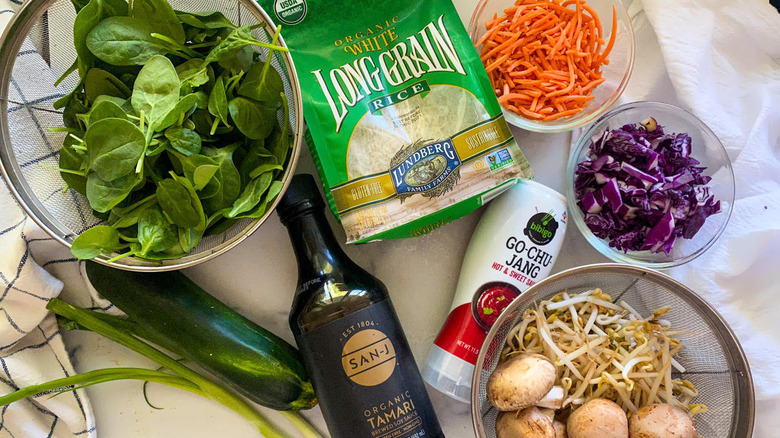Vegetarian Bibimbap Recipe
If you've never prepared or tried bibimbap before, you are in for a real treat. This recipe is a 100% vegetarian meal that's jam-packed with rice and veggies. Wellness coach and recipe developer Miriam Hahn, who puts together delicious and nutritious meals you can find on her Instagram, has put together a fantastic combination of rice and Korean flavor in this recipe that's quick and easy to whip up. Plus, it's a one-serving recipe — perfect for when you're preparing a meal for just yourself.
All you need for real bibimbap is rice, since "bibimbap" itself is literally a combination of the word for mixing rice and the word for rice. As Hahn explains, "Bibimbap actually means 'mixed rice,' because you are mixing all sorts of other great foods with the rice. Traditionally, the bibimbap bowls all have the great gochujang sauce." Complete with a bunch of tasty veggies, this is a meal that just about anyone will enjoy, regardless of their dietary restrictions.
Gather the ingredients for vegetarian bibimbap
While the shopping list isn't necessarily a short one, most of the ingredients here are vegetables. Start with a large zucchini, which you'll cut in half. You'll also need mushrooms, bean sprouts, spinach, and shredded carrots. Grab one purple cabbage and a bunch of scallions, and that will wrap up your time in the vegetable aisle.
All you'll need to get now is a bag of rice (Although since this recipe calls for a cup of cooked rice, some fresh leftover rice would be fine.), a bottle of gochujang, and a bottle of soy sauce. Plus, you can pick up a fried egg, however, that's optional. Now that you have your big vegetable medley, you're ready to start assembling.
"It is always beneficial to eat a wide variety of colors when eating produce, because you are getting a very diverse range of vitamins, minerals, and fiber. That is why you often hear health professionals say 'eat the rainbow,'" explains Hahn. "Cabbage is a cruciferous vegetable loaded with sulforaphane, a compound shown to reduce and prevent cancer growth. Mushrooms [can aid in battling cancer]. Carrots, a superstar vegetable, [are] good for the eyes and skin. Zucchini and spinach both powerful greens. Bean sprouts have lots of vitamin C, and [they are] rich in minerals."
Prep the rice and vegetables
Start with the rice. Follow the instructions on the bag, and get that going. Since cooking the rice will last longer than the whole rest of the prep, that should be started before anything else. "[You will want to cook] about ½ cup uncooked if you don't have leftover rice to use," Hahn notes.
Next, get to slicing and dicing the vegetables for the bibimbap. The zucchini needs to be cut into matchsticks, the mushrooms need to be sliced (or you can get pre-sliced ones), the carrots need to be shredded, and the cabbage and scallions need to be chopped. It's easiest if you put them all into separate bowls, or they can be organized into piles on a large cutting board.
You will cook the zucchini, mushrooms, bean sprouts, and spinach. The carrots, cabbage, and scallions will be kept raw, however they will all mix together in the end.
Cook the vegetables
While you will be cooking about half the vegetables, they will cook separately. Add 1 tablespoon to a sauté pan, and warm it to medium-high heat. Once it's at the proper temperature, add the zucchini matchsticks and ½ teaspoon of the soy sauce. Sauté for five minutes until the zucchini is soft, but not mushy.
Once done, remove the mushrooms from the pan, and repeat with the sliced mushrooms, and add the remaining soy sauce. Once they're soft, remove from the pan, add another tablespoon of water, and cook the bean sprouts for three minutes. Finally, repeat the three-minute cook with the spinach, and you're done with all the cooking.
"The sprouts and spinach can be cooked to your preference or even left raw," Hahn explains. "I like to just warm up the sprouts and wilt the spinach, and it just takes about three minutes to do this. It is super quick!"
Finish your vegetarian bibimbap
Your rice should be ready by now. Layer some in the bottom of a wide, shallow bowl. "The rice just goes at the base of the serving bowl or any bowl you plan to eat from," Hahn notes.
Then, add the zucchini, mushrooms, bean sprouts, spinach, carrots, cabbage, and scallions on top of the rice. To do it properly, you want to arrange it in sections. "By 'sections,' I just mean grouped together verses all mixed together," explains Hahn. "This is mainly for looks, and you usually mix it before eating anyway, so this is up to the individual."
Next, add the gochujang sauce. "The sauce can go in a small ramekin if you are going to dip or just poured on and tossed if you want it more of a dressing. It is pretty spicy, so [it's] best to go easy if you haven't tried it before." Finally, you can add a fried egg on top if you want, either for another flavor or more protein or both. And then you're ready to dig in to this quick, easy, and filling vegetarian dish. "All around, this is a really healthy meal — and [it's] also delicious!"

- 1 cup cooked rice
- 4 tablespoons water, divided
- ½ large or 1 small zucchini, cut into matchsticks
- 1 teaspoon soy sauce, divided
- 1 cup mushrooms, sliced
- 1 cup bean sprouts
- 2 cups spinach
- 1 cup shredded carrots
- ½ cup purple cabbage, chopped
- 2 scallions, chopped
- 3 tablespoons gochujang sauce
- fried egg
- Prepare the rice if it's not already cooked.
- In a sauté pan, add 1 tablespoon of water, and bring to medium-high heat. Add the zucchini and ½ teaspoon of soy sauce. Sauté for 5 minutes until the zucchini is soft, but not mushy.
- Remove the zucchini from the pan. Repeat the previous step with the sliced mushrooms using the remaining soy sauce.
- Remove the mushrooms, and add another tablespoon of water to the pan in addition to the bean sprouts. Cook for 3 minutes.
- Remove the bean sprouts, and repeat the previous step with the spinach.
- Layer some rice in the bottom of a wide, shallow bowl.
- Add the zucchini, mushrooms, bean sprouts, spinach, carrots, cabbage, and scallions in sections on top of the rice.
- Add the gochujang sauce, and either dip as you eat, or toss the sauce and ingredients together.
| Calories per Serving | 454 |
| Total Fat | 4.8 g |
| Saturated Fat | 0.9 g |
| Trans Fat | 0.0 g |
| Cholesterol | 0.0 mg |
| Total Carbohydrates | 88.1 g |
| Dietary Fiber | 13.1 g |
| Total Sugars | 18.9 g |
| Sodium | 2,380.2 mg |
| Protein | 20.8 g |





